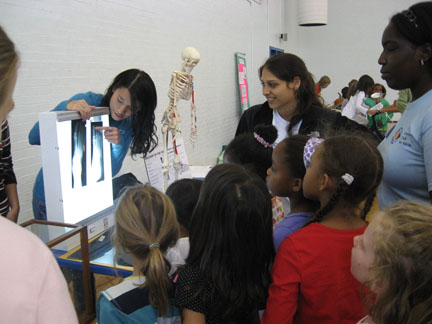Wellesley Students Pass on Science Knowledge Through Outreach
FOR IMMEDIATE RELEASE:
October 23, 2009 |
|
WELLESLEY, Mass. – Why is your big toe bigger than your other toes? How and why do foot and ankle injuries occur?
 |
Wellesley student Andrea Chang explains ankle and feet X-rays to kindergarten through seventh grade girls at the Science Clubs for Girls' event, "Where's the Science?"
held at Wellesley College. |
Wellesley College students in the course, “Sports Medicine,” aimed to answer these questions — and showcase the science in everyday life — for kindergarten through seventh grade girls at the annual Science Club for Girls’ (SCFG) kickoff event for the Newton branch, “Where’s the Science?” The fair was hosted at the Keohane Sports complex on the Wellesley College campus.
"It was an amazing experience for my students and they felt challenged with effective ways to communicate the material to the different age groups,” said Connie Bauman, coordinator of the Sports Medicine program at Wellesley and instructor of the course.
During the event, local girls from the Boys and Girls Club of Newton, Second Step Newton and the Myrtle Baptist Church rotated through science fair tables prepared by local companies, academic and community organizations— including Newton Wellesley Hospital, the Newton Fire Department, Northeastern University, Olin College of Engineering and more.
Wellesley students led the table, “Bone Up and Stretch Your Sole,” where they discussed the differences in lower leg anatomy of human and cats by observing cat skeletons, human foot models and X-rays of ankles and feet of humans. They also spoke about the role of ligaments in the body, placed athletic tape over the location of the ligaments in the participants’ ankles, and simulated movements that might cause ankle injuries to show how ligaments are stretched when these injuries occur.
“The most rewarding part for me was working with the girls one-on-one, especially the ones that were most unresponsive at first,” said Wellesley College senior Andrea Chang. “I saw one girl become more and more engaged with the material as we presented them with the cat skeleton, X-rays and ligament tape, to a point where she was finally asking me questions about the ligaments. It was so fun, and teaching the material really solidified it for me as well.”
Students also learned how to effectively teach the same concepts to different age levels.
“I found with the older children, it was best to ask what sport they played and then connect their sport, for example basketball, and act out throwing a shot and how I could sprain my ankle then,” said sophomore Amy Wolkin. “The younger ones loved walking around like a cat, but also learned more about why they jump off of their toes, and possibly why cats are four-legged.”
Wellesley College student volunteers were Grady Bailin, Andrea Chang, Hannah Dornbusch, Jessica Li, Cristin Scott, Jessica Whitley, Amy Wolkin, Regina Tahk, Jennifer Yang, Camille Hamilton, Ashima Sarup, Erica Namigai, Jasmine Rana, Hannah Morrison and Victoria Boyd.
“Our students seized an opportunity to teach science to young girls and make an impact in their lives,” said Jocelyne Dolce, a biology lab instructor at Wellesley and outreach coordinator for Wellesley College and SCFG. “Even better was the fact that the young girls were so excited by everything they learned throughout the day. Students who volunteer with Science Club for Girls often say that teaching science to young girls reminds them why they are studying science at Wellesley.”
The SCFG aims to increase the self-confidence and science literacy of K–12th grade girls belonging to groups that are underrepresented in the sciences, through free, after school programs that provide experiential learning, mentorship and leadership opportunities. Wellesley student regularly volunteer for the organization.
To read more about science outreach at Wellesley, visit http://new.wellesley.edu/Biology/template_outreach/template_model_2009/outreachindex.html.
Since 1875, Wellesley College has been a leader in providing an excellent liberal arts education for women who will make a difference in the world. Its 500-acre campus near Boston is home to 2,300 undergraduate students from all 50 states and 68 countries. For more information, go to www.wellesley.edu.
###
|

